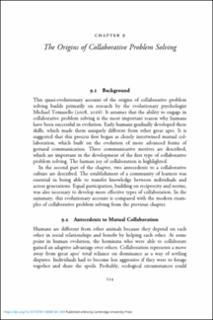| dc.contributor.author | Baltzersen, Rolf K. | |
| dc.date.accessioned | 2022-09-25T23:07:51Z | |
| dc.date.available | 2022-09-25T23:07:51Z | |
| dc.date.issued | 2022 | |
| dc.identifier.uri | https://hdl.handle.net/11250/3021115 | |
| dc.description | Chapter 9 in Cultural-historical perspectives on collective intelligence
In the era of digital communication, collective problem solving is increasingly important. Large groups can now resolve issues together in completely different ways, which has transformed the arts, sciences, business, education, technology, and medicine. Collective intelligence is something we share with animals and is different from machine learning and artificial intelligence. To design and utilize human collective intelligence, we must understand how its problem-solving mechanisms work. From democracy in ancient Athens, through the invention of the printing press, to COVID-19, this book analyzes how humans developed the ability to find solutions together. This wide-ranging, thought-provoking book is a game-changer for those working strategically with collective problem solving within organizations and using a variety of innovative methods. It sheds light on how humans work effectively alongside machines to confront challenges that are more urgent than what humanity has faced before. This title is also available as Open Access on Cambridge Core. | en_US |
| dc.description.abstract | Chapter 9 argues that the origins of collaborative problem solving can be traced back to mutual collaboration, which built on the evolution of more advanced forms of gestural communication. Elaborative collaborative problem-solving builds on this type of collaboration and requires proximate mutual interaction and sympathy between the collaborators. In contrast, rule-governed collaborative problem solving centers on an idea of fairness and requires that collaborators adhere to specific rules or norms in their collaboration. At least two collaborative cultures were key in the evolvement of this type of collaboration. First, stone tool learning require deliberate practice and the presence of a community of learners with norms. Explicit teaching and individual training built on purposeful activities that were considered valuable, a collaborative culture which over time made it possible to refine stone tools across generations. Second, it is likely that hunter-gatherer groups were important in the development of ideas on equal participation, building on reciprocity and norms that emphasized equal sharing of food. Calculated reciprocity represents a significant move away from the dominance of a few individuals in groups. Equal sharing of food required increased control of emotions and the establishment of norms that kept free riders out. A fair sharing of spoils also permitted role differentiation in groups because not everyone had to participate in the hunt in order to get food. | en_US |
| dc.language.iso | eng | en_US |
| dc.publisher | Cambridge University Press | en_US |
| dc.rights | Attribution-NonCommercial-NoDerivatives 4.0 Internasjonal | * |
| dc.rights.uri | http://creativecommons.org/licenses/by-nc-nd/4.0/deed.no | * |
| dc.subject | Mutual collaboration | en_US |
| dc.subject | Gestural communication | en_US |
| dc.subject | Pointing | en_US |
| dc.subject | Communicative motives | en_US |
| dc.subject | Requesting help | en_US |
| dc.subject | Informing others | en_US |
| dc.subject | Sharing feelings | en_US |
| dc.subject | The joy of collaboration | en_US |
| dc.subject | Collaborative culture | en_US |
| dc.subject | Community of learners | en_US |
| dc.subject | Boxgrove | en_US |
| dc.subject | Equal participation | en_US |
| dc.subject | Calculated reciprocity | en_US |
| dc.subject | Fair collaboration | en_US |
| dc.subject | Elaborative collaborative problem solving | en_US |
| dc.subject | Rule-governed collaborative problem solving | en_US |
| dc.subject | Collective intelligence | en_US |
| dc.title | The Origins of Collaborative Problem Solving | en_US |
| dc.type | Chapter | en_US |
| dc.description.version | publishedVersion | en_US |
| dc.rights.holder | Rolf K. Baltzersen | en_US |
| dc.source.pagenumber | pp 254-275 | en_US |
| dc.identifier.doi | doi:10.1017/9781108981361.009 | |

